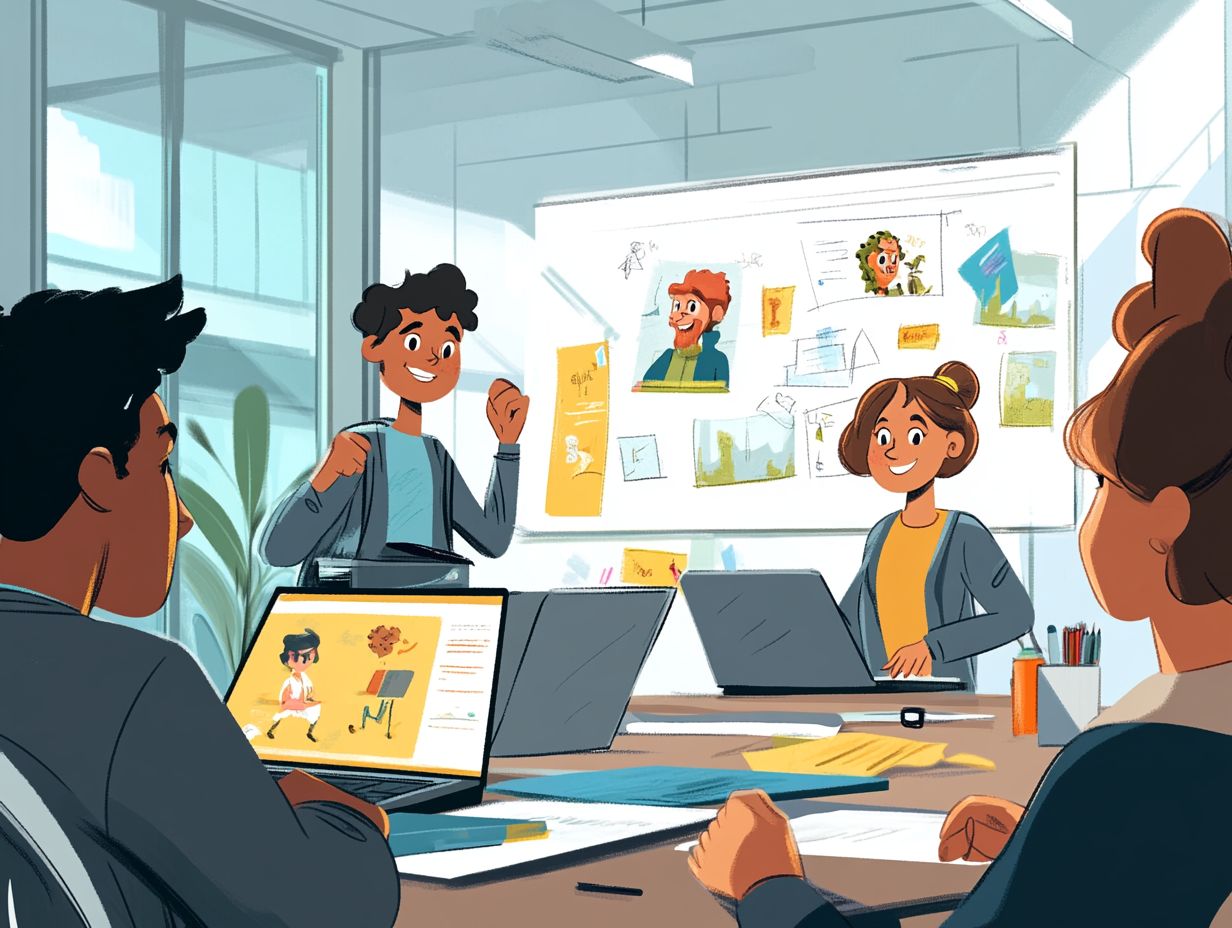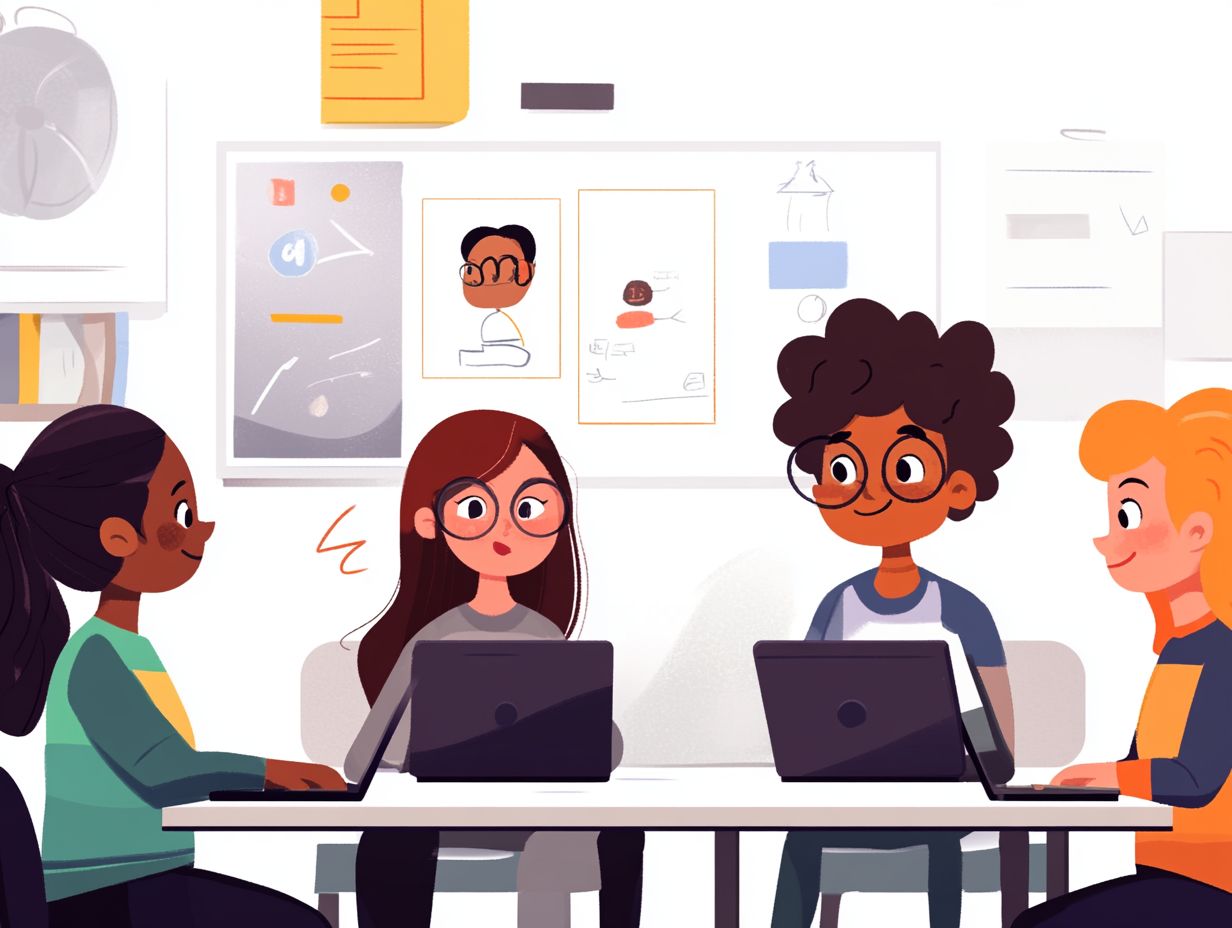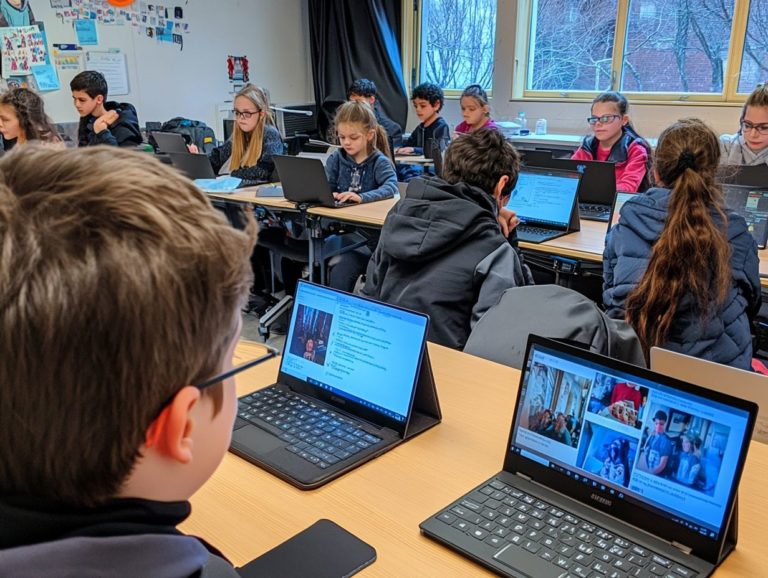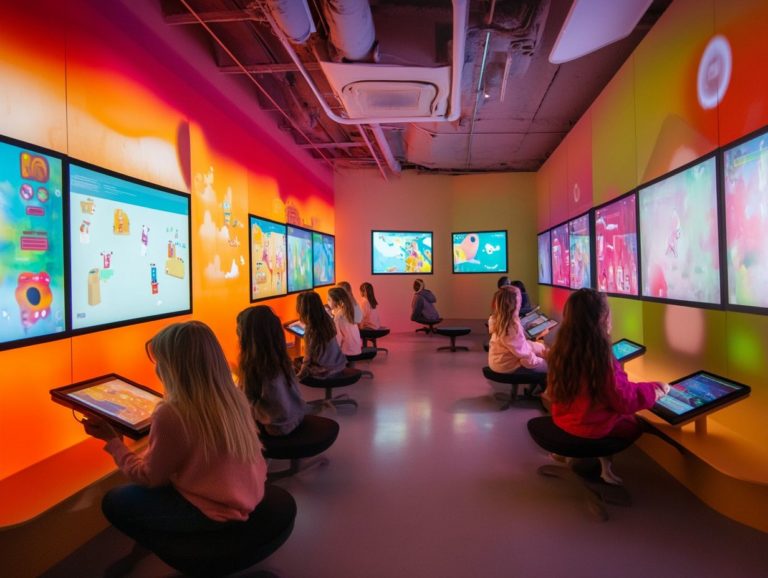5 Techniques for Storytelling in E-Learning
In today s digital learning landscape, storytelling has become an invaluable tool for captivating and engaging learners.
This article delves into five innovative techniques that can elevate your e-learning experiences, from using interactive scenarios to adding dynamic multimedia elements. It emphasizes the significance of compelling characters and explains how gamification using game-like elements to make learning more fun can boost motivation.
You ll discover effective storytelling tips, common pitfalls to steer clear of, and insights on how a narrative approach can accommodate diverse learning styles.
Dive in to unlock the secrets of transforming your e-learning courses from merely informative to truly unforgettable!
Contents
- Key Takeaways:
- 1. Using Interactive Scenarios
- 2. Incorporating Multimedia Elements
- 3. Creating Engaging Characters
- 4. Utilizing Gamification
- 5. Incorporating Real-Life Examples
- Why Is Storytelling Important in E-Learning?
- What Are the Key Elements of a Good Story in E-Learning?
- How Can Storytelling Enhance the Learning Experience?
- What Are Some Common Mistakes to Avoid When Using Storytelling in E-Learning?
- How Can a Storytelling Approach Benefit Different Types of Learners?
- What Are Some Tips for Creating a Compelling Story in E-Learning?
- Frequently Asked Questions
- 1. What are the 5 techniques for storytelling in E-Learning?
- 2. Why is creating a compelling narrative important in E-Learning?
- 3. How do multimedia elements enhance storytelling in E-Learning?
- 4. How do interactive scenarios contribute to effective storytelling in E-Learning?
- 5. How can real-life examples be incorporated into storytelling in E-Learning?
- 6. What is the role of character development in storytelling for E-Learning?
Key Takeaways:

- Use interactive scenarios to engage learners.
- Add videos and infographics to make your content memorable.
- Create relatable characters to help learners connect with the story.
1. Using Interactive Scenarios
Incorporating interactive scenarios into your eLearning modules significantly enhances the learner experience. By creating an engaging setting, you enable learners to actively participate in their education, improving knowledge retention and emotional connection through realistic workplace challenges.
You can explore various types of interactive scenarios, such as:
- branching simulations
- role-playing exercises
- situational judgment tests
These scenarios are designed to sharpen specific skills and knowledge areas. For example, a branching simulation allows learners to navigate choices in a customer service setting, enhancing their decision-making and problem-solving abilities.
Role-playing exercises can also immerse learners in negotiations or conflict resolution scenarios, fostering empathy and refining communication skills. These methods not only capture learners’ attention but also promote a learner-centered approach, encouraging exploration and practical application.
These scenarios create a safe space for learners to experiment and make mistakes an essential component for deep learning and personal development.
2. Incorporating Multimedia Elements
Adding multimedia elements to your eLearning courses like visual aids and auditory components can enrich your content while fostering an emotional connection that enhances learning outcomes.
By using a variety of formats like videos, infographics, and podcasts, you can cater to the diverse preferences of your learners. For instance, videos engage those who process information visually, while infographics present complex data in a concise, digestible format. Podcasts are ideal for auditory learners who prefer information during commutes or workouts.
Best practices dictate that you strategically embed these elements to ensure they align with your learning objectives and provide meaningful context rather than just filling space. This thoughtful integration promotes an interactive environment where all learners can thrive.
3. Creating Engaging Characters
Building engaging characters within your eLearning narratives enhances character development and fosters emotional connections, making the course content more relatable and impactful.
These character arcs guide you through complex concepts and scenarios, embodying the realistic challenges you may face in your career. For example, consider a character who navigates a crisis, showcasing effective conflict resolution skills; this helps you grasp these skills in a practical context. Similarly, a character dealing with team dynamics enhances your understanding of collaboration and communication in the workplace.
Such narratives transform an otherwise dry subject into an interactive journey, emphasizing the importance of personal growth and decision-making under pressure.
Start transforming your e-learning experience today!
4. Utilizing Gamification

Gamification transforms traditional training into vibrant experiences. By adding game-like elements such as points, levels, and instant feedback, you can boost learner motivation and engagement.
This approach involves setting up challenges tailored to different skill levels, allowing individuals to progress at their own pace while earning virtual rewards along the way.
For example, organizations like Cisco have successfully used gamified training systems. Cisco has experienced a significant boost in course completion rates and overall learner satisfaction. These strategies not only help with knowledge retention but also create a community of collaborative learners, enriching the entire training experience.
5. Incorporating Real-Life Examples
Incorporating real-life examples enriches eLearning content and enhances relatability. This makes it easier to grasp complex concepts like workplace ethics and emotional intelligence through practical applications.
When discussing workplace ethics, scenarios where employees face ethical dilemmas can provoke thoughtful analysis of your own values. Imagine a case study where a team member uncovers a colleague’s unethical behavior this can spark engaging discussions about accountability and transparency.
Similarly, role-playing exercises that simulate conflict resolution can provide a perfect opportunity to practice empathy and communication skills. These contextual learning strategies help bridge the gap between theory and practice, enabling you to navigate real-world challenges more effectively.
Why Is Storytelling Important in E-Learning?
Storytelling captivates learners, fostering emotional engagement and enriching the learning experience. It turns abstract concepts into relatable narratives that resonate with your personal and professional life.
By weaving complex ideas into stories, you can retain information more effectively while understanding its real-world applications. Techniques like character development, conflict resolution, and plot progression are essential for making content engaging. Encountering a case study featuring a relatable protagonist facing career challenges sparks empathy and deepens understanding.
This immersive approach not only boosts knowledge retention but also enhances communication skills, encouraging you to articulate your own experiences in relation to the story. Leveraging storytelling leads to more impactful learning outcomes.
What Are the Key Elements of a Good Story in E-Learning?
A compelling eLearning story weaves emotional connections, dynamic training, and relatable learner protagonists. This narrative approach captures attention and facilitates deeper understanding by engaging you on multiple levels.
Focus on essential elements such as plot structure, character development, and dramatic tension. A well-defined plot should present a clear beginning, middle, and end, guiding you through challenges that mirror real-life scenarios. Character development allows you to see yourself in the journeys of the story’s heroes.
By adding dramatic tension, you invest emotionally in the outcomes. Tailoring these storytelling components creates a more immersive environment, encouraging critical thinking and making lessons more memorable and impactful.
How Can Storytelling Enhance the Learning Experience?

Storytelling elevates your learning experience by transforming challenges into relatable narratives that inspire and motivate you. This method enables you to connect with the material on both an emotional and intellectual level.
For instance, when educators present historical events through personal accounts or fictionalized characters, you gain insight into the human side of history. This approach moves beyond mere dates and facts. It taps into the power of emotional storytelling, making complex subjects like physics or biology more accessible by situating concepts within real-life scenarios.
Imagine a teacher illustrating the laws of motion through the captivating journey of a young astronaut. This not only captures your imagination but also effectively imparts essential scientific principles. By integrating relatable stories, educators foster engagement and enhance memory retention, transforming the learning experience into something truly enjoyable and impactful.
What Are Some Common Mistakes to Avoid When Using Storytelling in E-Learning?
When you incorporate storytelling into eLearning, be mindful of common pitfalls that can compromise the effectiveness of how you teach. Neglecting audience analysis, misaligning narratives with learning objectives, and overcomplicating stories can all detract from learner engagement.
To craft compelling narratives, step into the learner’s shoes and consider their unique experiences, preferences, and challenges. Simplifying storylines is key; this way, the essential messages can shine brightly without overwhelming participants with extraneous details.
Creating relatable characters and scenarios can deepen connections. This makes the learning process feel more engaging and relevant. It’s important to revisit learning goals during the development phase. This ensures that every story element contributes to enhancing understanding and retention.
How Can a Storytelling Approach Benefit Different Types of Learners?
A storytelling approach in eLearning can truly elevate your learning experience by catering to various learning preferences. Whether you’re an auditory, visual, or kinesthetic learner, this method enhances adult learning and creates a more personalized journey for you.
For instance, as an auditory learner, you might find yourself captivated by narratives that engage your listening skills, utilizing spoken words and sound effects to evoke emotions. If you lean toward visual learning, rich imagery and videos can effectively illustrate concepts, making them easier to grasp.
Incorporating interactive elements like quizzes and discussion prompts adds another layer of engagement. This is especially beneficial for kinesthetic learners who thrive on hands-on experiences. Personalization is key; by tailoring stories to reflect your background and interests, you ll feel more motivated and develop a deeper connection to the material.
This exciting approach helps you get the most out of your learning experience, no matter your style!
What Are Some Tips for Creating a Compelling Story in E-Learning?
Creating a compelling story in eLearning requires careful consideration of storytelling techniques, effective character development, and maintaining a clear focus on achieving desired learning outcomes. For more insights, check out these tips for creating engaging e-learning videos that truly resonate with your audience.
To engage your learners meaningfully, it s vital to pay attention to pacing. A well-paced story captures interest and keeps your audience invested in the outcome. Introducing conflict can serve as a powerful tool. It challenges characters and fosters problem-solving, reflecting real-life scenarios your learners might encounter. Aligning the narrative with specific learning objectives not only enhances the content’s relevance but also reinforces key concepts.
By thoughtfully integrating these elements, your narrative transforms into an exciting way to learn. This ensures that learners leave with not just information, but also a memorable experience.
Frequently Asked Questions

1. What are the 5 techniques for storytelling in E-Learning?
The 5 techniques include creating a compelling narrative, using multimedia elements, incorporating interactive scenarios, leveraging real-life examples, and developing characters.
2. Why is creating a compelling narrative important in E-Learning?
A compelling narrative engages learners and holds their attention.
This approach makes content relatable and memorable.
3. How do multimedia elements enhance storytelling in E-Learning?
Multimedia elements like images, videos, and audio make the story come alive.
They convey information in visually appealing ways, enhancing engagement.
4. How do interactive scenarios contribute to effective storytelling in E-Learning?
Interactive scenarios let learners participate actively in the story.
This makes learning immersive and helps retain information.
5. How can real-life examples be incorporated into storytelling in E-Learning?
Real-life examples make content relatable.
They show how concepts can be applied practically, reinforcing learning meaningfully.
6. What is the role of character development in storytelling for E-Learning?
Character development builds a connection between learners and the story.
Relatable characters keep learners invested and engaged throughout the course.






